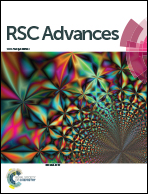A polysulfobetaine hydrogel for immobilization of a glucose-binding protein
Abstract
A hydrogel based on sulfobetaine methacrylate monomer N-(methacryloyloxyethyl)-N,N-dimethyl-N-(3-sulfopropyl)ammonium betaine and N,N-bis(methacryloyloxyethyl)-N-methyl-N-(3-sulfopropyl)ammonium betaine used as a crosslinker was investigated as a potential material for biosensor applications. The glucose diffusion coefficient of 1.2 × 10−10 m2 s−1 was determined from the glucose release experiment. Inverse size-exclusion chromatography was performed to determine the molecular weight cut-off of the hydrogel to be 8 kDa with respect to pullulans that corresponds to a viscosity radius of 2.1 nm. The narrow pore-size distribution suggests that using the sulfobetaine crosslinker suppresses the composition drift and results in a homogeneous hydrogel network. Furthermore, a glucose biosensor construct comprising the periplasmic glucose-binding protein of Escherichia coli fused to cyan and yellow fluorescent proteins was effectively entrapped in the hydrogel exhibiting no leakage for at least 7 days. The glucose-binding protein showed stability of its secondary structure and sensitivity to glucose as assessed by circular dichroism and Förster (fluorescence) resonance energy transfer measurements under physiological conditions and a physiological range of glucose concentration, respectively.


 Please wait while we load your content...
Please wait while we load your content...